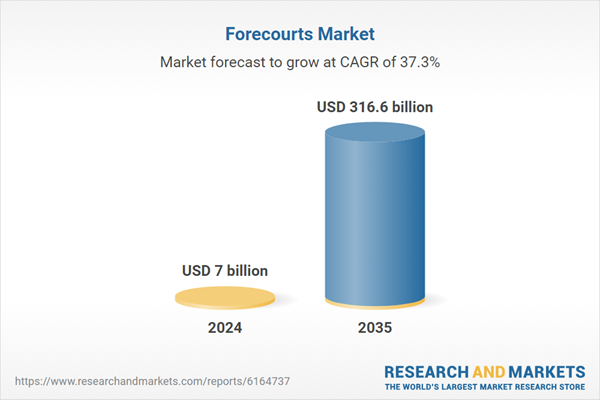The forecourts market is projected to grow from USD 7.0 billion in 2024 to USD 316.6 billion by 2035 at a CAGR of 37.3%. Globally, governments are promoting clean mobility through subsidies for EV charging and forecourt infrastructure development. These policy measures support both capital investment and long-term growth in forecourt deployment and operations.
The revenue from charging points segment holds the largest share in the forecourts market, primarily driven by the rapid rise in electric vehicle (EV) adoption and supportive government policies encouraging electrification. As EV users spend more time at charging stations, they are increasingly engaging in ancillary activities such as shopping, dining, or vehicle care. This consumer behavior is significantly boosting the revenue generated from value-added services. Furthermore, the integration of grid-connected battery energy storage systems (BESS) enables forecourts to capitalize on fluctuating energy markets by selling stored electricity during peak demand periods. With energy prices expected to rise during these peak intervals, the revenue potential from the energy storage segment is projected to grow substantially over the forecast period.
Revenue from Energy Storage Service (BESS and V2G) segment to register highest growth
There is a surge in energy storage technologies like BESS and Vehicle-to-Grid (V2G). These technologies are no longer complementary add-ons but are emerging as central revenue streams. With the expansion of EV adoption, the pressure on grid infrastructure is mounting, necessitating smarter, decentralized energy management solutions. BESS and V2G offer forecourts a profitable revenue model, where energy is not just dispensed but also stored, managed, and traded. Therefore, between 2025 and 2035, the revenue generated from energy storage services at forecourts is expected to grow exponentially.
Moreover, the cost of lithium-ion battery packs - central to both BESS and V2G - has declined significantly, reducing capital expenditure for forecourt operators. As battery technology continues to mature and economies of scale are achieved, implementation becomes more affordable and scalable. Therefore, this trend is expected to play a key role in accelerating the adoption of energy storage services.
Asia Pacific and Europe to hold significant shares in forecourts market
In Asia Pacific, footfall at forecourts remains high due to their strategic locations - near highways and urban entry points, they are being prioritized for EV charging point installation. These sites serve as ideal locations for fast-charging infrastructure due to their accessibility and ability to handle high volumes of vehicles. Additionally, the typical dwell time of nearly half an hour during EV charging aligns well with the usage patterns of customers seeking quick convenience or rest stops.
Europe's stringent emission norms and the EU green deal are pushing the entire region toward clean mobility. Forecourts are adapting by installing EV charging infrastructure, positioning themselves as pillars of the transition. Additionally, major energy players like TotalEnergies, BP, and E.ON are investing in forecourt upgrades across Europe, supporting the rollout of thousands of new charging points and smart retail stations.
The ongoing developments in public transit and EV ecosystem, coupled with the high investment from energy giants, are projected to drive the forecourts market in the European and Asia Pacific regions.
In-depth interviews were conducted with CEOs, marketing directors, other innovation and strategy directors, and executives from various key organizations operating in this market.
- By Company Type: Energy Players - 45%, Convenience stores - 25%, OEMs - 5%, Charging Point Operators - 10%, E-forecourt Retailers - 15%
- By Designation: C Level - 40%, Directors - 40%, and Others - 20%
- By Region: North America - 20%, Europe - 30%, and Asia Pacific - 30%,
The forecourts market is led by established players such as GRIDSERVE (UK), Motor Fuel Group (MFG) (UK), Rontec (UK), Circle K (US), and SHELL RECHARGE (US).
Key Benefits of Buying the Report:
The forecourts market report will help market leaders and new entrants with information on the revenue segments of forecourts, including revenue from charging, value-added services, and energy storage systems. It will also help stakeholders understand the competitive landscape and gain more insights to better position their businesses and plan suitable go-to-market strategies. The report also helps stakeholders understand the market's pulse and provides information on key market drivers, restraints, and opportunities.
The report provides insights into the following points:
- Analysis of key drivers (charging points as revenue-generating hubs, rise in EV adoption), restraints (rise of decentralized charging infrastructure, cost and convenience of home charging), opportunities (monetization through BESS, V2G as a two-way revenue stream) influencing the forecourts market.
- Product Development/Innovation: Detailed insights into development activities, upcoming BESS and V2G project plans in the forecourts market
- Market Development: Comprehensive information about the lucrative market (the report analyzes the forecourts market across varied regions)
- Market Diversification: Exhaustive information about business opportunities, revenue potential, untapped geographies, and investments in the forecourts market
- Competitive Assessment: In-depth assessment of growth strategies, and service offerings of leading players like GRIDSERVE (UK), Motor Fuel Group (MFG) (UK), Rontec (UK), Circle K (US), and SHELL RECHARGE (US) in the forecourts market
Table of Contents
1. Executive Summary
Table Information
| Report Attribute | Details |
|---|---|
| No. of Pages | 58 |
| Published | August 2025 |
| Forecast Period | 2024 - 2035 |
| Estimated Market Value ( USD | $ 7 billion |
| Forecasted Market Value ( USD | $ 316.6 billion |
| Compound Annual Growth Rate | 37.3% |
| Regions Covered | Global |









